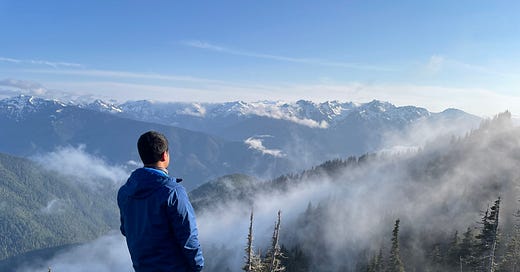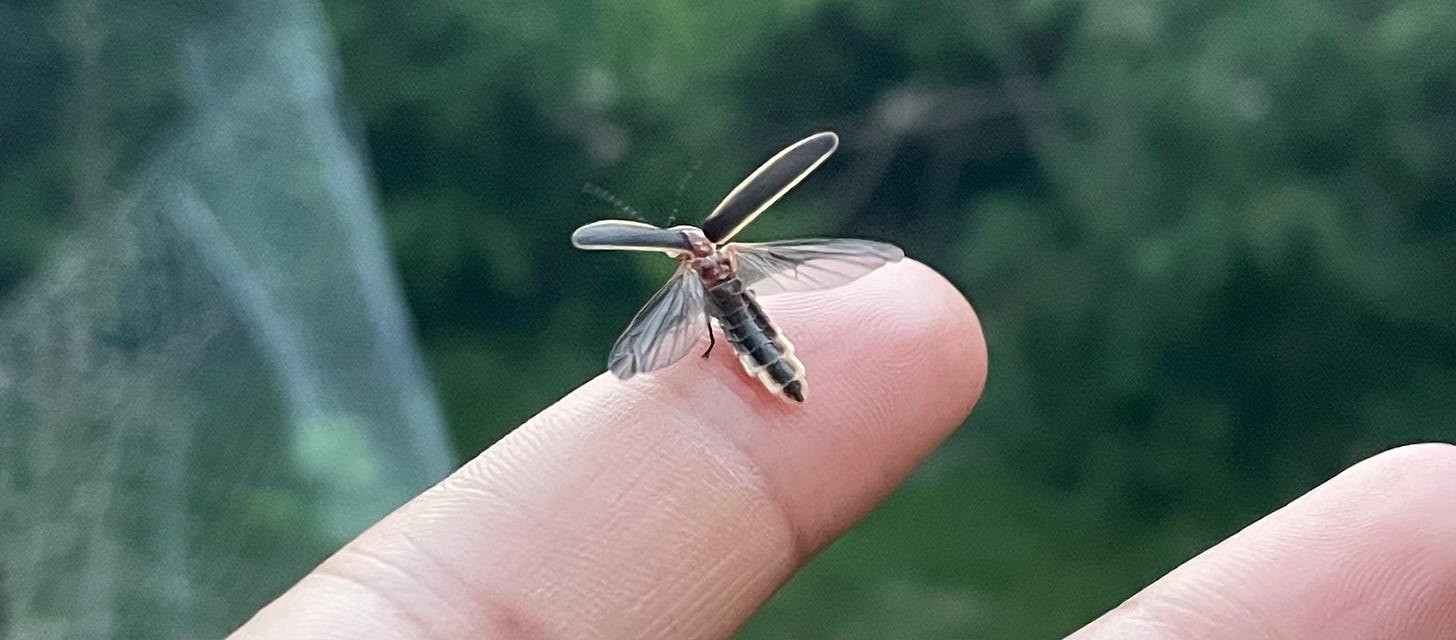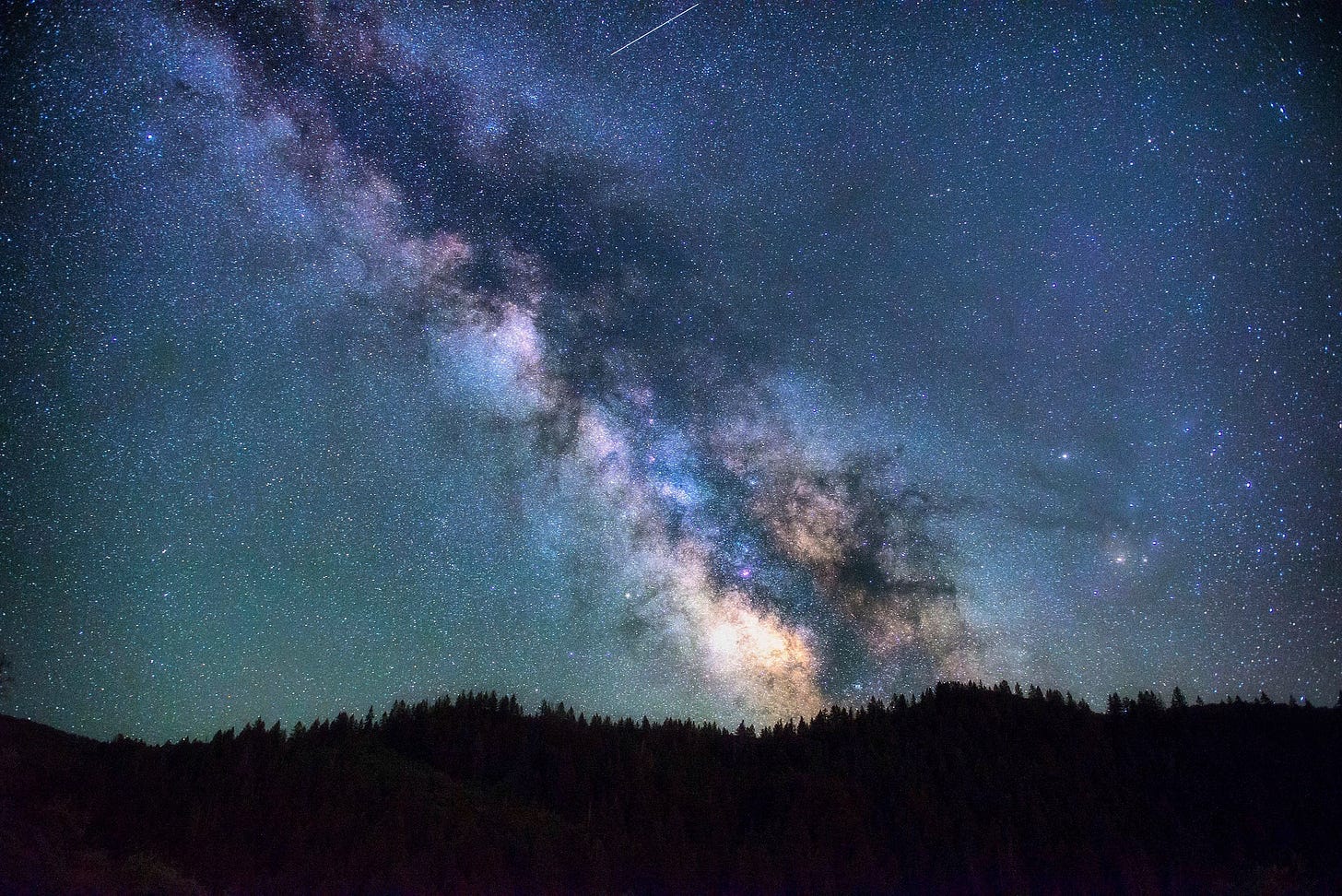“Nature transcends our tendencies to label and classify. To reduce and limit. The natural world is unfathomably more rich, interwoven, and complicated than we are taught, and so much more mysterious and beautiful. Deepening our connection to nature will serve our spirit, and what serves our spirit invariably serves our artistic output.”
~ Rick Rubin, The Creative Act: A Way of Being
Wherever humans settle and “civilize” the land with roads, buildings, telephone poles, and lights, fireflies, just like the stars in our sky, begin to vanish. Habitat loss, light pollution, and pesticide use are some of the primary reasons firefly populations are a mere sliver of what they once were.
A few weeks ago, I was walking back inside the house after feeding our turkeys and ducks their evening meal, when I paused for a moment. The grass felt cool under my bare feet, the air was warm and dry, and the thrum of crickets and cicadas was almost deafening. The sun was getting low, but another form of light was increasing. Fireflies. Our entire yard glittered with minuscule but bright yellow lights that flashed on and off in perfect synchronization. I do not remember ever seeing this many fireflies in one place. I’m hoping their numbers have bounced back in our area of southeastern Michigan. Perhaps they’ve become more resilient to human activities. After all, life will find a way.* I stood there for a few minutes enjoying nature’s performance. A natural concert. Audience in attendance: one.
When a firefly hatches out of its egg, it is in the larval stage. Firefly larvae look like tiny, upgraded versions of the sandworms from Dune (2021). They are often brightly colored, sport three pairs of legs, and their exoskeletons look like armor-plating. Add to this arsenal a set of sharp mandibles and a voracious appetite, and you’ve got yourself a keystone species. These larvae will kill and consume vast quantities of worms, slugs, snails, and countless other invertebrates. They inject paralyzing chemicals into their prey before beginning to consume them. Firefly larvae must grow and mature quickly to enter into the next stage of their lives; the pupal stage. Thus, during a firefly larvae’s quest to turn into a pupa, it will devour surprisingly large quantities of other organisms. Additionally, the firefly larvae themselves are prey for a number of creatures, such as birds and lizards. In essence, healthy firefly populations stabilize entire food webs.
Those of us that live in large cities with 9-5 jobs may go to work each day or the grocery store each week to buy processed foods wrapped in harmful plastics, paying no mind to the environment around us or the sky above us, let alone fireflies, which do not even live there. The sky has few or no stars in large cities. It is black, and the ground is paved. Sometimes there’s a moon, but it is often hidden by the presence of buildings or houses. Crickets and cicadas do not sing here, and if they tried, their songs would be drowned out by the incessant noise of vehicles whizzing about and polluting the air. Though there are numerous pros to living in a bustling city that I do not take for granted, these kinds of places have lost their magic. It is one of the greatest tragedies of the modern world.
NOTE: Before you read further, please PLAY THIS SONG as you read (the music gets really good a bit further in, so skip a little ahead and start playing from past the 5-minute mark or so).
Stars and fireflies once lit up the nights of the past. During those primeval times when the simple pleasures of a full stomach and a place to lay were enough to expunge all our desires. Hunter-gatherers would sit around bonfires and chew on meat from an animal they killed not too long ago, while surrounded by fireflies beneath starry skies. Darkness was ablaze with supernatural light as children played and adults laughed over the crackle of a roaring flame. And then came story time- a mystical activity that led to the formation of all our ideas and inventions. Science. Math. History. Philosophy. Art. All of it has been influenced deeply by the old stories.
We told these stories to one another under the cosmos. Under great galaxies, shooting stars, harvest moons, and constellations. Under the divine white disc that is the incredible Andromeda Galaxy, another reality in the universe over 2.5 light-years away from ours. Under that dark belt of stars and planets that gracefully cuts across the inky blackness of the night sky with the ferocity of a trillion suns, which is the Milky Way. Under the ominous red glare of a blood moon. Under Orion the Hunter, Sagittarius the Archer, Draco the Dragon, and many other cosmic works. The sky was alive at night. When you looked up, it must have seemed like there were more stars than black.
To think that each and every star is still up there in our sky, each one at the exact position as it was during countless story-time sessions from generation after generation of hunter-gatherers families. Now, much of the cosmos is simply not visible in areas with light pollution- where most of us currently reside. The world today is far less magical. Many of us have forgotten that those stars are even up there. That the universe is far larger than our lives. That the fireflies still fly.
Conservationists are warriors of the light.* We are protectors of starry skies and fireflies. Together we stand. Together we fight.
*Reference to the fictional character Ian Malcolm's quote, “But life finds a way,” from the 1990 novel, Jurassic Park by Michael Crichton.
*Reference to Paulo Coelho’s “warrior of the light” concept from his novel, Warrior of the Light: An Inspirational Companion to the Alchemist.





